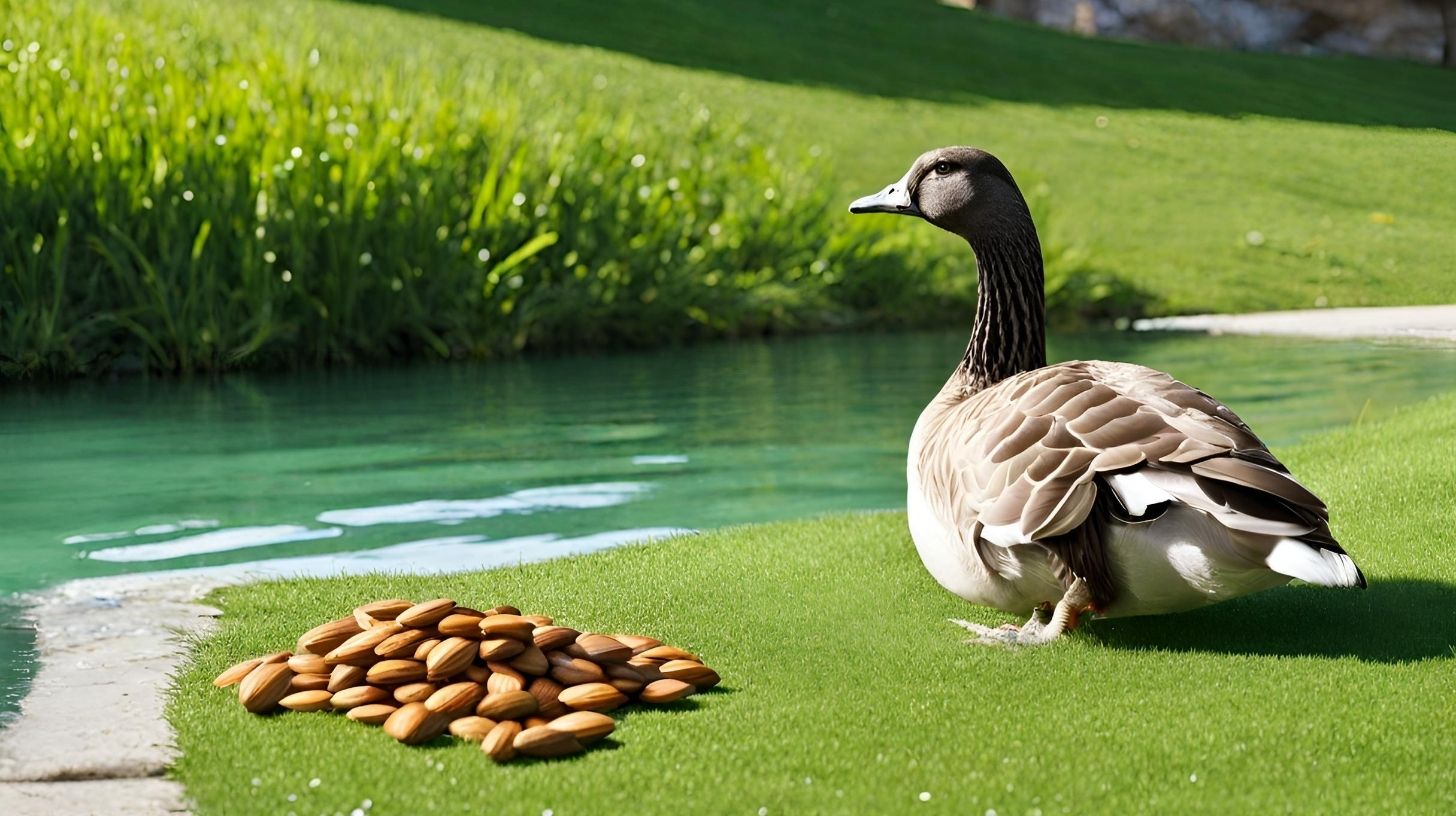Do Geese Lay Unfertilized Eggs? Discover The Answer!

Table of content:
Geese are remarkable creatures that have some interesting reproductive behaviors when it comes to laying and caring for their eggs. One common question that arises is whether geese lay eggs even if they are not fertilized. The short answer is yes, geese do lay unfertilized eggs fairly frequently.
Why Geese Lay Unfertilized Eggs
There are a few key reasons why geese often lay eggs that are not fertilized:
Seasonal Egg Laying
Geese are seasonally prolific egg layers. They typically begin laying eggs in early spring and may continue laying eggs nearly every day for several weeks or months. This intensive egg production is driven by increasing daylight hours and warming temperatures, not necessarily the presence of a male goose.
So even without a gander around, the female goose’s reproductive system kicks into high gear in the spring and produces eggs. While many of these eggs may get fertilized if a male is present, plenty of unfertilized eggs will also get laid.
No Male Geese Present
In some situations, there may be female geese (known as goose hens) present without any male geese (ganders). This would obviously lead to unfertilized eggs since mating has not occurred.
Even in mixed flocks, the male-to-female ratio is often skewed, with 2-3 females for every male. Under those conditions, not every female may have access to a male for successful breeding and fertilization.
Young, Immature Geese
Younger female geese may start trial nesting or laying eggs in their first spring season while they are still sexually immature. These adolescent geese have not bred with males and so their eggs are unfertilized. It takes geese 1-2 years to reach full sexual maturity.
Breaks in Broodiness or Mating
There are times when a paired male and female goose may temporarily separate or stop mating consistently. Then the female lays some eggs that happen to be unfertilized before she reunites with the gander.
Geese remain fertile and able to lay viable eggs for many years, but there can be natural breaks in breeding activity. This allows for gaps where the goose lays eggs that are not fertilized because the pair are not constantly mating.
What Happens to Unfertilized Goose Eggs?
So what becomes of all these unfertilized eggs that geese lay? There are a few common outcomes:
Discarded Eggs
If no embryo develops because the egg was never fertilized, most geese will simply abandon or discard the egg after a few weeks of incubation. Once the goose realizes the egg will not hatch, she may push it out of the nest or carry on with incubating just the viable eggs.
In natural settings, abandoned eggs are often eaten by predators or scavengers who discover them. Unfertilized eggs left uneaten eventually dry out or rot.
Eaten by Geese
Geese are opportunistic eaters and will consume their own unfertilized eggs, especially if better sources of nutrition are scarce. The eggs provide protein and calcium that helps sustain the goose during the energy-intensive breeding season.
This egg eating and recycling may seem distasteful to us, but it allows geese to reabsorb nutrients from the egg they expended energy producing.
Collected by Humans
Unfertilized goose eggs can end up getting collected by people and eaten. In-home flocks, owners may take some of the unfertilized eggs for their own use rather than leaving them for the geese.
Commercial goose egg producers also harvest unfertilized eggs from their flocks since they have no need for viable hatchlings. The unfertilized eggs still have value for human consumption.
Allowed to Hatch
While unfertilized goose eggs will never develop an embryo, some geese will stubbornly sit on and try to incubate these eggs. If this continues for the full incubation period, the unfertilized eggs may even “hatch” in the sense that the gosling forces its way out of the egg.
Of course, no live gosling emerges because the egg was never fertilized. But some geese tenaciously incubate all their eggs regardless of fertility status.
Do Geese Know Which Eggs are Unfertilized?
Geese have some capacity to sense which of their eggs are developing normally and contain embryos. However, geese do not immediately know whether an egg is fertilized or not at the time it is laid.
Several factors give clues to the goose if certain eggs are not viable:
Lack of Egg Development
Over the roughly 30-day incubation period, fertile goose eggs will gradually grow larger and develop an air pocket inside as the embryo forms.
Unfertilized eggs maintain their original size and weight as incubation progresses. The goose may abandon eggs that fail to increase in size or show signs of growth.
Candling the Eggs
Using a bright light source placed behind the egg, geese can “candle” their eggs to see inside them. Fertilized eggs will show a dark mass and network of veins from the developing embryo.
In unfertilized eggs, the interior looks empty and unchanged. Candling allows geese to identify which eggs are developing and focus their efforts on incubating those.
No Hatching Gosling
After patiently sitting on an egg for 4 full weeks, geese know something is amiss if no gosling breaks out from the shell. This confirms that the non-hatching egg was unfertilized and not viable.
honking at eggs
The parents will sometimes honk at their eggs. They can tell by the echo if the egg is fertilized and contains a developing gosling or if it is unfertilized. Different interior densities and structures create subtle sound differences.
So while geese do not immediately know at laying if an egg is fertile or not, they have evolved several methods to determine viability as incubation proceeds. This allows them to adaptively focus attention on nurturing the eggs that have the highest probability of hatching.
Do Geese Care for Unfertilized Eggs?
When geese lay clutches of 6-12 eggs, it is common for some of those to be unfertilized. Do geese still devote energy to incubating and caring for eggs they lay that are not actually viable?
In most cases, yes geese do initially sit on and incubate all their eggs in a clutch. They typically do not abandon or exclude any eggs from the nest until it becomes clear some are not developing. Reasons geese incubate all eggs include:
Unable to Tell Initial Fertility Status
As discussed above, geese cannot definitively identify fertilized vs unfertilized eggs immediately after laying them. So they incubate all eggs until signs of non-viability become clear.
Instinct and Hormones
Strong hormonal drives to reproduce and nurture offspring ensure geese sit on all eggs following laying. Their instincts do not distinguish between fertile and infertile eggs.
Potential Embryo Viability
Even if mating was infrequent, some apparently unfertilized eggs may get fertilized. Sitting on all eggs gives even those a chance to develop into goslings.
Lack of Energy Cost
Incubating all laid eggs initially does not require much extra energy expenditure by geese. They only have to differentiate once some eggs clearly fail to hatch.
So while geese will discard unfertilized eggs eventually, they do provisionally incubate and guard all eggs once the clutch is complete. This gives even apparently infertile eggs a chance. It also simplifies behavior rather than immediately judging viability.
Do Other Birds Lay Unfertilized Eggs?
While geese provide a clear example, many other avian species also commonly lay unfertilized eggs. Any birds that exhibit:
- Seasonal egg-laying cycles
- High female-to-male ratios
- Young, non-breeding females
- Separation of mated pairs
May all produce some portion of eggs that are unfertilized. Besides geese, other birds like chickens, ducks, quail, turkeys, penguins and swallows frequently lay eggs that never get fertilized. Yet the reproductive urge to keep laying persists.
This tendency is not actually wasteful or surprising. Birds evolved laying cycles timed more for food availability than the presence of mates. Unfertilized eggs get recycled or discarded. As long as the female can adequately nourish some offspring, laying unfertilized eggs is of little consequence to the overall reproductive success rate.
Why Don’t All Eggs Hatch?
While this article focuses on unfertilized eggs, it is worth noting that not all fertilized eggs successfully hatch either. After fertilization by a male, causes for embryo death include:
- Genetic defects
- Poor egg turning during incubation
- Incorrect incubation temperature and humidity
- Damage or breakage of egg
- Egg rotation and positioning errors
- Attack by microbial infections
- Toxic substances penetrating the shell
- Female goose abandoning nest prematurely
So while unfertilized status accounts for many non-viable eggs, plenty of fertilized eggs also fail to fully incubate. Even if an embryo starts developing, many hazards can still prevent it from fully forming and hatching.
Do Unfertilized Eggs Taste Different?
This raises the final question of whether consumers can taste any difference between fertilized and unfertilized goose eggs. With an unfertilized egg, there is no embryonic development happening inside the shell.
But the internal components of the egg itself like the albumen, yolk and membranes are functionally identical in composition. Food-wise, the egg is essentially the same whether it got fertilized or not.
The major factors that impact egg flavor and texture are actually the diet and age of the laying female goose, not the fertilization status. Pasture-raised geese typically produce more flavorful eggs than commercially confined geese. But within a controlled goose flock, fertilized and unfertilized eggs taste essentially indistinguishable.
So unfertilized goose eggs can be enjoyed just as much as fertilized ones! The key is having high standards for housing, feeding and care of the laying geese. Their diet and living conditions impart more flavor to the eggs than fertilization alone.
In summary, geese commonly lay unfertilized eggs as an artifact of their prolific seasonal laying cycles. While geese lack the ability to identify unfertilized eggs at laying, they can assess developing fertility in the weeks after. Geese do sit on all eggs initially but will reject non-viable ones over time.
Unfertilized eggs end up discarded, eaten or collected by humans. Though not developed, they remain a highly useful and tasty food source.
The tendency to lay unfertilized eggs is shared by many wild bird species and domesticated poultry. It arises from reproductive behaviors evolved for maximum production, not reliance on male availability.
So while surprising to some, laying and even eating unfertilized eggs is perfectly natural goose behavior. It highlights the amazing productivity and resourcefulness of these unique waterfowl!
Final Thoughts
Geese continue to fascinate with their interesting reproductive behaviors and high egg output. While some eggs invariably go unfertilized, adaptive behaviors like egg candling, incubating all eggs initially, and consuming their own undeveloped eggs reveal the intricate ingenuity of geese. Waste not, want not took on real meaning long before humans came along!
Hopefully, this provided a helpful overview of why geese lay unfertilized eggs and what purposes they still serve. Geese show that even when life doesn’t emerge, eggs can nourish in other ways.
Welcome. I’m Adreena Shanum, the proud owner of this website, and I am incredibly passionate about animals, especially poultry. I founded adreenapets.com as a labor of love, stemming from my desire to share my knowledge and experiences with poultry enthusiasts worldwide.




